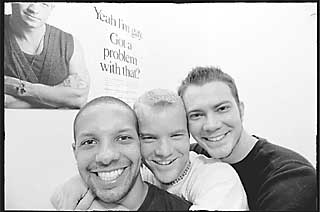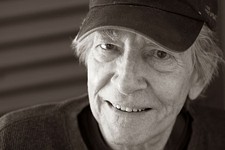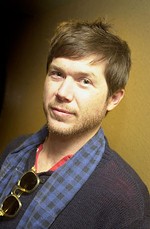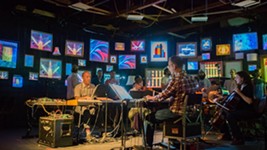The Art of Conversation
How to Socialize in the Age of AIDS
By Clay Smith, Fri., Sept. 24, 1999

On a Friday night earlier this summer, seven young gay men were watching television at a house in South Austin. They had gathered to watch a movie, but Mad TV was on. The manic energy of a sketch about the murder of JonBenet Ramsey prompted one of the men to offer a theory: It was the mother who did it. She went down into that basement and found her husband doing awful things -- awful sexual things -- to JonBenet. So she flipped out and threw something at him but hit JonBenet instead and killed her. It's a typical theory, but in an atypical setting. Friday night is Movie Night at the Austin Men's Project, a "community building project" that aims to foster a supportive environment in which young gay and bisexual men can "socialize, share, and encourage each other about safer sex and other issues of importance to us." At the Austin Men's Project, even theorizing about the JonBenet Ramsey murder can be socially beneficial.
The Center for AIDS Prevention Studies (CAPS) at the University of California at San Francisco, which funds the men's project, has produced compelling evidence that "informal communication -- within interpersonal networks" can play a crucial role in decreasing unsafe sex among young gay men. Project organizers assert that young gay men (those 18-29 years old) would take fewer risks with unsafe sex -- and HIV researchers agree they seem to be taking risks at disturbingly high rates -- if they felt a stronger sense of community. To that end, CAPS hired three young gay Austinites in March to coordinate the men's project activities out of a leased home in South Austin (hint: It's not on Nellie Street). By next March, when funding from CAPS runs dry, the organizers hope to have obtained funding from state and federal grants or foundations to keep the program going.
Since March, then, the men's project coordinators have been on a crusade to reach every young gay, bisexual, and curious man in Travis County. When they reach them, though, they don't give them lectures about HIV. Rather, they engage participants in a variety of formal and informal discussion groups, parties, and sports events that tend to feature safer sex messages but in a subtle, sub rosa manner. Anyone who seeks out HIV prevention advice can receive it through the project, but that's not exactly the reason someone would attend the Men's Project events.
In focus groups CAPS researchers conducted with young gay men in the San Francisco Bay area, participants described gay men who were likely to have AIDS as "older men with moustaches who go to leather bars."
"The prolonged incubation period of HIV infection feeds this misperception, since men who become infected in their early twenties are not likely to show symptoms until they are in their thirties," CAPS researchers wrote in AIDS, a professional journal, in 1990. The researchers have also determined that young gay men are staying away from AIDS service organizations (such as AIDS Services of Austin) in droves. Thus, CAPS has implemented programs in Eugene, Oregon; Santa Cruz and Santa Barbara, California; Albuquerque, New Mexico, and now Austin, that rely upon a social focus to preventing HIV among young gay men.
"There's a variety of reasons why young gay men do not access the organizations that have grown up around HIV," says Sandy Bartlett, the community information and education coordinator at AIDS Services of Austin. "Their experience is simply dramatically different in a lot of respects than, say, my generation, let's say anyone 32 or older. -- We saw firsthand the devastation that was being wrought by the disease, and if that doesn't yank you into a state of reality pretty quick, I don't know what will." But younger gay men have grown up with AIDS information. "They have grown up in an age of AIDS," Bartlett says, "-- but given the long incubation period of this disease, they probably do not know anyone who has suffered significantly -- yet. Now they may know HIV-positive people, but their social circles have not been devastated by sickness and death from AIDS, so their perspective is significantly different." Current HIV treatments have prolonged good health, which, Bartlett says, gives young gay men the perspective that, "Gee, maybe this disease isn't so bad after all."
Playing It Safe
Bartlett also confirms what HIV educators have been pointing out for some time, that most young gay men do not have the fully developed social skills that would allow them to successfully navigate a tense sexual situation. "They just get all hot and bothered between the legs and they go home and what happens, happens," Bartlett says. "And you can be talking with them and they will say, "Well, it just happened.' Well, of course, I could sit there and tell them didactically that nothing ever "just happens.' But the reality is for them, they didn't mean to, but they did not know how to get out of the situation once the ball was rolling. Or as a matter of fact, they may not particularly have wanted to get out of the situation. -- These guys are struggling in a morass of unknowingness."
CAPS hopes to intervene in the morass. "Friendship may be the central organizing element of gay men's lives," Peter Nardi writes in Gay Men's Friendships: Invincible Communities. Nardi declares that friendship is "the mechanism through which gay masculinities, gay identities, gay cultures, and gay neighborhoods get created, transformed, maintained, and reproduced. Friendship appears, as forcefully as any human behavior, at the intersection of self and society where the individual and the community reside."
The men's project itself resides at the intersection of self and society; in August 1996, CAPS researchers published an article in the American Journal of Public Health that explains why: "First, since HIV prevention is not in itself sufficiently motivating or captivating for young gay men, they tend not to seek out HIV prevention services. Thus, a successful HIV prevention intervention needs to relate HIV risk reduction to the satisfaction of other compelling needs. Since social concerns are highly motivating for young gay men, a social focus was adopted as the central theme of the intervention."

Social concerns: How do people react to me? What should I wear today? When will I fall in love? But also: How easy is it for people to tell that I'm gay? Do I care? Let's say I'm in rural America, how do I not get beaten up like Matthew Shepard? "I think we talk about things that normally most people don't talk about with their partners or people they're in a relationship with," says 22-year-old Brian Toynes, one of the three coordinators and a UT undergraduate. "Sometimes it's easier to talk with perfect strangers than it is to talk with somebody who you may love or care about or worry about what they think of you." To facilitate that talk, the project offers a seemingly endless roster of events. Toynes acts as a sort of administrator at the project, doing the paperwork and producing promotional materials -- there are many of them -- while David Sweeney, 26, who has worked at several local gay bars, concentrates on outreach, and Jesse Carter, 25, a UT psychology major, coordinates special events, managing the large parties the men's project holds every six weeks. "In the beginning," Carter says, "we had party after party after party -- Oscars party, Spring Fling, Cinco de Mayo -- and it was just one after the other and we didn't get a lot of the sort of structural and everyday issues worked out. Like, we didn't have stuff going on at the house every night, we didn't have drop-in hours, we didn't have a calendar. And we didn't have a brochure and we didn't have an e-mail list going because we were just busy with, "Okay, let's get this party [going], we've got to get our name out there.'"
"From all the communities we've worked in, Austin probably offers the most for young gay men," says Dr. Robert Hays, a CAPS research psychologist and co-founder of the Austin Men's Project and similar programs, such as MPower in Albuquerque. Every Monday night, people come over to watch Ally McBeal or play volleyball; Tuesday night is the weekly Core Group meeting, when 15 to 20 active volunteers get together to give input and make decisions about issues from the direction the project should be taking, to what sort of music should be played at the next party. Wednesday nights are Outlet discussion groups that feature experts from the community engaging participants in topics like "Religion, Spirituality, and the Modern Young Gay Man" and "Sex, Dating & Relationships."
The project's UnPlugged sessions -- informal, one-time meetings with eight to 10 men who talk in-depth about issues that affect them and the gay community -- occur on a different day each week. There are nights when Sweeney leads the volunteers of his outreach team to do "outreach," a rather drab term for what is essentially performance art. Recently, to publicize the program to young gay college students returning to Austin for the school year, Sweeney and his volunteers went to local gay bars dressed up in football gear, where they offered school cheers and distributed "lunch bags" that had information about the program and safe sex materials.
Explicitly Speaking
The Austin Men's Project is confounding. Just when all the talk about "fostering trust" and "caring" and "sharing" seems a little too -- therapeutic, not quite hip enough for young gay men, the project coordinators manufacture events that are quite obviously the products of edgy, vibrant, and outspoken imaginations. At a "Lava Luau" party in June, coordinators and Core Group members bestowed plastic Hawaiian leis on partygoers. Attached to the leis were pieces of paper that upon closer inspection revealed little packages containing a condom and lubricant. A ditty of sorts was printed on the paper with fetching graphics: "Hey guys -- there's a lot more to hot, safe sex than condoms and getting lei'd. For instance -- a hula tells a story: illustrate your love with the way you move your body," and so on, in increasingly sexually specific language that details in a humorous and witty fashion the mechanics, as it were, of safe sex. At the project's first large party, the Spring Fling held in March, this piece of advice accompanied the safe sex materials handed out in little plastic bags: "Wrap your spring before you fling." It's kind of touching to realize that someone has conjured up all that linguistic imagination and cute packaging to tell you how to have sex.
And just when you conclude that the project provides a space and community whose participants seem to have fun despite the absence of alcohol and that that policy might put a dent in the idea that gay men have to be around a bar if they wish to be around other gay men, the project coordinators insist their program is not in opposition to but "complementary" to gay bars, though it is trying to effect cultural change in a community that has traditionally had only one sanctioned gathering place: bars. Hays says the project doesn't necessarily want people "to stop going to bars and come to the men's project. That's something that bar owners are sometimes sensitive to, that we're competing with them. -- There are certain reasons people go to bars, but it doesn't necessarily satisfy all their needs, like it's hard to have more in-depth, personal conversations at bars, it's hard to really get to know people.
"It's true of HIV programs all over the country," he says, "that sometimes bar owners are just not as cooperative with the outreach workers for a lot of reasons. They might think HIV is sort of a downer, and they keep their patrons separate from that or they feel the outreach would be disruptive to the patron, interfere with their business, or make a mess, like have condoms all over the floor and bother their customers." Saturday night is generally left open on the the project's schedule.
Coordinators are trying to effect nothing less than a sea change in cultural mores. They refer to their organization as being "fraternal, but not a fraternity"; it's "jocular and it sometimes gets serious but then it's also very lighthearted and humorous and people really open to new people, to themselves," Sweeney says. "The biggest behavior pattern that is getting young men infected are not people who are having open relationships," he explains, "and it's not people who are sleeping with 20 guys every month or something. It's guys who are in relationships, in monogamous relationships for short periods, three or four months, and they either don't or they stop using condoms or they stop having safe sex in the context of a "relationship.' They're getting HIV from their boyfriends."
It's not necessarily that their boyfriends are cheating on them, he is careful to explain, but they may not have been tested in the recent past. They don't look like they might have HIV. "Because of this bond they form with this person," Sweeney says, "they feel they can trust them and, you know, emotionally, I'm not saying that they can't trust them. But there's this virus there that sometimes shows up and what we're trying to do is -- I don't know -- create a culture change in which that intimacy isn't something that's so desperately needed."
It must be a very daunting task trying to change people's behaviors by such a subtle methodology, but CAPS seems to have hired people who are convinced they can do it. All three coordinators have immersed themselves in Austin's gay and lesbian community; they exude that hard-earned but casual sort of confidence that is the result of being very well-connected. If most of us are separated from one another by six degrees, it's likely that we're only separated by two or three from the project coordinators. "You know, I used to be a club kid when I was 18 years old," Toynes says. "And I would sneak out of the house and go out dancing all night long at what used to be called Area 52, and that's where I met this whole sub-group, and I was a prep and I met all these groups. You know, I go out to the bars and people are like, "God, you know everybody,' and it's more that I met these people from the old days," which were four years ago.
Hays says that he and his colleagues look for initiative, commitment to the gay community, and dedication to HIV prevention in potential coordinators. They should be "friendly," "outgoing," and "creative" people. "We look for, a lot of it is personal qualities," Hays says, "because we recognize that a lot of young gay men may not have the experience in doing a lot of the things that we need in the program." Sweeney has worked at AIDS Services of Austin, Toynes at Informe/SIDA, and all three project coordinators have worked together since April 1998, when they formed a community-building organization called GYM (Gay Young Men) that was a precursor of sorts to the project, except that GYM had no money and no expertise provided by HIV research psychologists in San Francisco. Eventually, the three men "suspended operations" at GYM once they found out that CAPS would be instituting a community-building project in Austin, and they applied to become project coordinators.
The three vow to keep the program running beyond next March even if it doesn't receive funding. And Hays has a different sort of success story in mind for the project. It involves a young man who comes from a small town, moves to Austin, but doesn't really know anyone. He knows that he is gay but he hasn't become involved in the gay community; he doesn't know how to meet other gay people. "So that person might find out about [the men's project] and say, "Look, it's a way to meet [people],'" Hays postulates, "and -- come to it, and meet a lot of other young gay men who are in similar situations as himself.
"We're trying to get people talking about issues that they may not normally talk about," Hays says, "because that contributes to a strong, healthy community. -- It's one big goal -- you need them to be having safe sex, you need them to be having open and honest communication in order to have a well-rounded life." ![]()
The Austin Men's Project can be reached at 447-4270 or on the Web at http://www.austinmensproject.com.
Got something to say on the subject? Send a letter to the editor.








